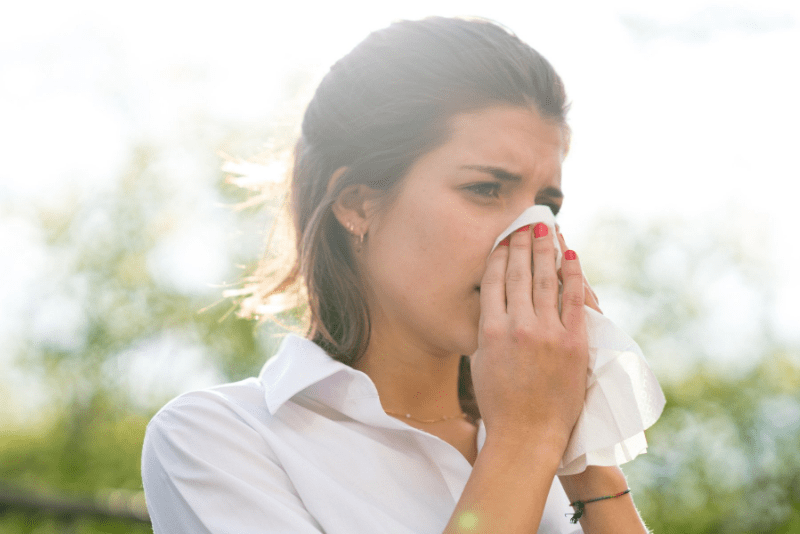From their puppy kisses to their gentle purrs, pets have a way of wagging their tails straight into our hearts. It’s not an exaggeration to say that our pets are part of that family. So, what happens when one of your children becomes allergic to your fur baby? At Charleston Allergy and Asthma, we’ve experienced (and solved) this problem firsthand, and we’re standing by to help you do the same!
If you find your child is sneezing and sniffling thanks to their furry best friend, don’t send Fido to the pound! There are solutions you can adopt to help you and your pet comfortably cohabitate.
How do pets cause allergies?
Allergies are the result of “biological miscommunication.” Our symptoms develop when the immune system misidentifies a seemingly harmless foreign substance as an allergen, triggering an allergic cascade that releases histamine and other natural substances resulting in allergy symptoms.
Contrary to popular belief, it is more than only pet hair that causes pet allergies. The other misidentified invaders that cause allergies include urine, saliva or dander, with dander being the most common due to its minuscule size, airborne nature and tendency to cling to fabrics such as clothes and furniture. While breeders may suggest a “hypoallergenic” breed, no animal is truly hypoallergenic–just those with a lower tendency to cause allergies.
What are common pet allergy symptoms?
For the most part, pet allergy symptoms are easy to spot. It’s their close resemblance to common cold symptoms that make their identification a little trickier.
Your child may be living with pet allergies if they are experiencing any of the following symptoms:
- Sneezing or runny nose
- Itchy, red and watery eyes
- Coughing
- Sinus pressure or congestion
- Allergic dermatitis
In some cases, pet allergy reactions may also trigger asthma attacks or urticaria (hives)
Monitor your child’s interactions with your pet, and, if symptoms persist for more than two weeks, it is possible pet allergies may be the cause. Your board-certified allergist will be able to conduct an allergy test to help you and your child discover the root cause of their symptoms.
How can I alleviate my child’s pet allergy symptoms?
As we mentioned previously, there are steps you can take to help alleviate your child’s allergy symptoms while keeping your family intact. Giving up your pet should never need to be an option since the following solutions are readily available.
- Overcome your child’s allergies through immunotherapy treatment. First and foremost, we recommend beginning immunotherapy treatments. This series of allergy shots are administered in appointments over a three to five-year period, during which minuscule amounts of the culprit allergen are introduced to your child’s immune system to help desensitize them to their specific allergiesand reduce their symptoms. Immunotherapy is considered to be the closest thing to an allergy cure and has been used by several of our doctor’s family members to help them live comfortably alongside their own furry friends.
- Create an allergy-free space for your child. Limiting your pets to only one or two rooms can help greatly reduce the spread of allergens throughout the home and provide your child with safe spaces for symptom-free living. This can often be a first step as your child begins the desensitization process through immunotherapy.
- Invest in a HEPA purifier. While not completely eliminating allergens from the space, a high-efficiency particulate air (HEPA) filter can be an excellent tool for drastically reducing lingering allergens in the air.
- Bathe your pet regularly. Weekly baths are perfect for reducing built-up dander and other allergens caught in your pet’s fur. However, make sure not to over-bathe as this can have the opposite of the desired effect by drying out your pet’s skin.
- Test out your child’s pet allergies (safely). While dander is a common cause of pet allergies, it is also possible that your child’s reactions may be to a completely unrelated source. Pollen and other outdoor allergies can easily stick to your furry friend’s coat, just as with clothing. It may be possible that your child is allergic to these allergens rather than ones directly related to your pet. An allergy test is the best way to determine this.
Let’s put allergies in the dog house!
At Charleston Allergy and Asthma, our pet-loving team of board-certified allergy experts is always here to help you thrive. If you or your child are currently living with untreated allergy symptoms, we would love to help improve your quality of life! Contact us today to schedule your visit at one of our Lowcountry locations.




